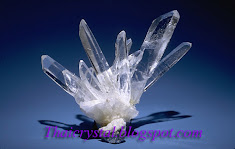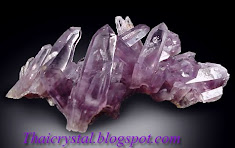The mineral beryl is a beryllium aluminium cyclosilicate with the chemical formula Be3Al2(SiO3)6. The hexagonal crystals of beryl may be very small or range to several meters in size. Terminated crystals are relatively rare. Pure beryl is colorless, but it is frequently tinted by impurities; possible colors are green, blue, yellow, red, and white. The name comes from the Greek beryllos , which referred to a precious blue-green color-of-sea-water stone. The term was later adopted for the mineral beryl more exclusively. The name is actually of Indian origin. The beryl is also a stone in the Jewish High Priest's breastplate, described in Exodus
Emerald refers to green beryl, colored by trace amounts of chromium and sometimes vanadium. The word "emerald" comes (via Middle English: Emeraude, imported from Old French: Ésmeraude and Medieval Latin: Esmaraldus) from Latin smaragdus from Greek smaragdos - ("green gem"), its original source being a Semitic word izmargad or the Sanskrit word, marakata , meaning "green". Most emeralds are highly included, so their brittleness (resistance to breakage) is classified as generally poor.
Emeralds in antiquity were mined by the Egyptians and in Austria, as well as Swat in northern Pakistan. A rare type of emerald known as a trapiche emerald is occasionally found in the mines of Colombia. A trapiche emerald exhibits a "star" pattern; it has raylike spokes of dark carbon impurities that give the emerald a six-pointed radial pattern. It is named for the trapiche, a grinding wheel used to process sugarcane in the region. Colombian emeralds are generally the most prized due to their transparency and fire. Some of the most rare emeralds come from three main emerald mining areas in Colombia: Muzo, Coscuez, and Chivor. Fine emeralds are also found in other countries, such as Zambia, Brazil, Zimbabwe, Madagascar, Pakistan, India, Afghanistan and Russia. In the US, emeralds can be found in Hiddenite, North Carolina. In 1998, emeralds were discovered in the Yukon.
Emerald is a rare and valuable gemstone and, as such, it has provided the incentive for developing synthetic emeralds. Both hydrothermal and flux-growth synthetics have been produced. The first commercially successful emerald synthesis process was that of Carroll Chatham. The other large producer of flux emeralds was Pierre Gilson Sr., which has been on the market since 1964. Gilson's emeralds are usually grown on natural colorless beryl seeds which become coated on both sides. Growth occurs at the rate of 1 mm per month, a typical seven-month growth run producing emerald crystals of 7 mm of thickness. The green color of emeralds is attributed to presence of Fe3+ and Fe2+ ions.

Custom Search

















































